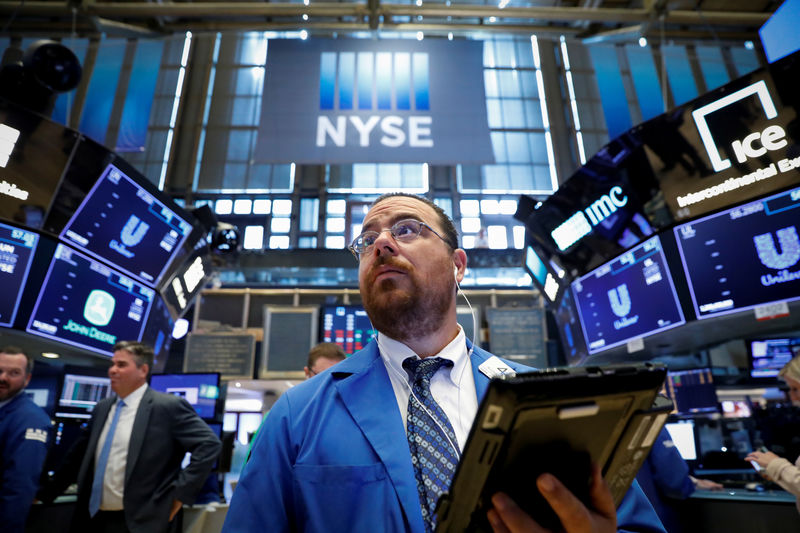Investing.com - Stocks surged for a third-straight day on optimism about a U.S.- China trade deal and fewer worries about a recession hitting any time soon.
With Monday's rally, the major averages have recovered most of the losses suffered in last week's wild gyrations.
The S&P 500 was up 1.2%, and the Dow Jones industrials rose nearly 1%. The Nasdaq Composite jumped 1.35% and moved above 8,000 for the first time in four sessions.
Chip stocks led technology shares higher after the Trump Administration extended its reprieve on penalties for doing business with Huawei, the Chinese telecommunications equipment company. The Philadelphia Semiconductor Index rose nearly 1.9%. Nvidia (NASDAQ:NVDA) and Micron Technology (NASDAQ:MU) were the leaders.
That was about the only real news on the China-U.S. trade fight, but it was good enough.
Twenty-eight of the 30 Dow stocks were higher, led by Cisco Systems (NASDAQ:CSCO) and chemical maker Dow Inc (NYSE:DOW). At their highs in the morning, the blue chips were up as many as 336 points.
The tech-dominated Nasdaq 100 index, up 115 points, or 1.52%, was led by Chinese internet retailer Baidu (NASDAQ:BIDU), Nvidia and Wynn Resorts (NASDAQ:WYNN), one of the biggest players in Macau.
In addition, oil prices moved higher on hopes that any kind of deal could boost oil demand. West Texas Intermediate crude was up $1.33 to $56.14 a barrel on Monday. Brent crude, the global benchmark, was up $1.10 to $59.74. WTI is still down more than 15% from its $66.30 peak in April.
The demand for stocks pulled interest rates higher, with the 10-Year Treasury yield rising 4.4% to 1.608%, its highest level since Aug. 13. The 2-Year Treasury yield rose to 1.549%.
Since Wednesday's shocking selloff that saw the Dow fall about 800 points, the blue-chip index is up 2.6%. The S&P 500 has rebounded 2.92% and the Nasdaq Composite has risen 2.94%.
Volatility has dominated markets as the worries have intensified about the economic impact of the U.S.-China trade battle. It has affected business in both countries. Electronics companies have become especially vulnerable to the shifting political winds. U.S. farmers have been stressed because China has been their largest export market. While the two sides are starting to communicate, no deal is expected until next year at the earliest.
In the 14 trading days so far in August, the Dow has experienced nine days with gains or losses of at least 239 points. The S&P 500 has moved up or down 1% or more on eight occasions and the Nasdaq has seen eight days of 100-point gains or losses.
There is plenty of opportunity for more volatility over the next four weeks with earnings reports expected from Home Depot (NYSE:HD), Kohl's (NYSE:KSS), Lowe’s (NYSE:LOW), Target (NYSE:TGT), Nordstrom (NYSE:JWN) and Dick’s Sporting Goods (NYSE:DKS).
There will also be minutes from the Federal Reserve's July meeting due Wednesday and every word uttered at the Fed's annual retreat in Jackson Hole. Wyo., will be scrutinized. All of this will lead up to the Fed's September meeting when the central bank is expected to trim its key federal funds rate.
While bond markets have been signaling the potential of a recession in the next year or two, it's not clear if consumers are paying much attention.
Lastly, watch to see if the major averages can hit new highs. So far, new highs in the last two years have been met by near-immediate selloffs.
Winners and Losers in the S&P 500
Estee Lauder (NYSE:EL), Nvidia and Wynn were among the top S&P 500 performers on Monday.
Alliance Data Systems (NYSE:ADS), which organizes concepts like brand-centric bank credit card programs, health insurer DaVita HealthCare Partners (NYSE:DVA) and troubled conglomerate General Electric (NYSE:GE) were among the worst-performing stocks.
